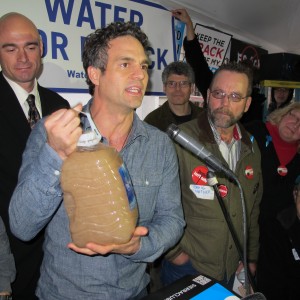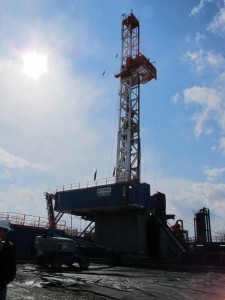LA Times: EPA Not in Agreement Over Dimock
Regional officials with the Environmental Protection Agency based in Philadelphia did not agree with EPA’s national office to close the investigation on water contamination in Dimock, according to a piece published in Sunday’s Los Angeles Times. An internal Power Point presentation leaked to the Times shows at least one staffer at Philadelphia’s region 3 office linked contaminants such as methane, arsenic and manganese to nearby gas drilling.
“Yet as the regulator moved to close its investigation, the staff at the mid-Atlantic EPA office in Philadelphia, which had been sampling the Dimock water, argued for continuing the assessment.”
The Times article doesn’t say who at region 3 wanted to continue the investigation, nor did it describe their role in the process. One question seems to hinge on whether or not the methane detected in the water wells came from shallow formations, or bears the imprint of the deeper Marcellus Shale gas. But Region 3’s assessment seems to agree with the investigation carried out by the Pennsylvania Department of Environmental Protection back in 2009, finding Cabot Oil and Gas responsible for methane migration in ten Dimock water wells.
“The presentation, based on data collected over 4 1/2 years at 11 wells around Dimock, concluded that “methane and other gases released during drilling (including air from the drilling) apparently cause significant damage to the water quality.” The presentation also concluded that “methane is at significantly higher concentrations in the aquifers after gas drilling and perhaps as a result of fracking [hydraulic fracturing] and other gas well work.”
Some argue that whether or not the methane came from a shallow or deeper shale formation is irrelevant, because faulty well construction could cause even the shallow deposits to migrate into the aquifer.
Although Cabot signed a consent decree with the DEP, the company says gas drilling did not cause any contamination, and that its own internal investigation showed the high levels of methane existed in the town’s water supply before gas drilling began. The company is still barred from drilling in certain areas of Dimock.
Dimock has become a battleground for pro and anti-gas drilling forces, especially after the release of Gasland, a film by Josh Fox that features the struggles of families who experienced high levels of methane and other contaminants in their well water. (Gasland 2 has since been released by HBO).
Listen to the voices of Dimock residents on both sides of the debate.
The Environmental Protection Agency got involved in Dimock after state regulators released Cabot Oil and Gas from the requirement to provide clean drinking water to affected residents. In January, 2012, the EPA informed the residents that it would provide water to four households and test the water at more than 60 homes. The EPA said further evaluation of water tests showed dangerous levels of barium, arsenic and other “hazardous substances.” Both Cabot and the DEP criticized the EPA’s decision to step into the Dimock controversy. Michael Krancer, then head of Pennsylvania’s Department of Environmental Protection, wrote a scathing letter to the EPA. Cabot released a report saying federal regulators misconstrued the lab results.

Susan Phillips / StateImpact Pennsylvania
Gas drilling in Dimock has drawn both national and international attention. Here, actor Mark Ruffalo stands with affected residents at a rally in the village after the DEP decided Cabot could end free water deliveries.
Still, the EPA tested drinking water from 64 households in the village of Dimock between January and June, 2012.
On July 25, 2012, the EPA announced it had completed its testing of drinking water supplies in the Susquehanna County village, and would halt its water deliveries. The EPA says it did find hazardous levels of barium, arsenic or manganese in the water supplies of five households. But the Agency said treatment systems could reduce the amount of toxins to safe levels.
At the time, EPA Regional Administrator Shawn Garvin said no more action was needed to protect the public health of Dimock residents, with regard to drinking water.
“The sampling and an evaluation of the particular circumstances at each home did not indicate levels of contaminants that would give EPA reason to take further action,” said Garvin. “Throughout EPA’s work in Dimock, the Agency has used the best available scientific data to provide clarity to Dimock residents and address their concerns about the safety of their drinking water.”
Garvin also emphasized at the time that the EPA’s mission in Dimock was not to investigate whether or not gas drilling caused the contamination, rather, to determine residents could safely drink their well water.
A spokesperson for the EPA in Washington, D.C. recently told the Los Angeles Times that the leaked presentation was a “preliminary evaluation” conducted by one employee. The article does not include a copy of the document, but gives this description:
“The presentation provides charts for nine of the 11 Dimock-area wells, tracking natural gas production work in the area and the concentration of methane and metals over a four- to five-year period, depending on the well. Some wells underwent a “short-term disruption,” or a rise in methane in the water six to eight months after nearby gas development activity. Over two or three years, the concentration of methane fell.
Four other wells experienced long-term disruption to their water quality, according to the presentation. In those instances, methane levels did not fall over time but remained high after an initial increase or began to climb after a period of decline. The presence of metals such as manganese and arsenic also rose over time in some of those wells.”
In August 2012, shortly after the EPA ended its investigation of Dimock’s water wells, all but one of the families settled their lawsuit with Cabot Oil and Gas. Terms of the agreement are not public. But in a call with investors, near the time of settlement, Cabot Oil and Gas CEO Dan Dinges had this to say:
“The aggregate value of the settlements are not a material item with respect to Cabot’s financial statements. Resolution of this litigation will have a very positive impact on G&A going forward due to the reduction in cost of defense.”
In fact, Cabot has done well since that call, with 2012 production and revenue exceeding all expectations. The company’s recent second quarter report also shows its earnings more than doubled compared to last year.

















